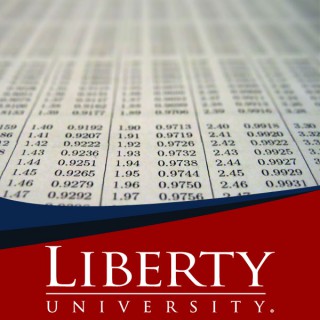Podcasts about normal distribution
- 26PODCASTS
- 44EPISODES
- 20mAVG DURATION
- ?INFREQUENT EPISODES
- May 30, 2023LATEST
POPULARITY
Best podcasts about normal distribution
Latest news about normal distribution
- Machine Learning Optimization with Optuna Towards Data Science - Medium - Jun 25, 2024
- Multivariate Normal Distribution Deep Learning on Medium - May 31, 2024
- Continuous Adaptive Learning — Reinforcement Learning with Normal Distribution Artificial Intelligence on Medium - Aug 14, 2023
- Finance: Where the Normal Distribution is Abnormal and the Abnormal is Normal BizToc - Apr 11, 2023
- Unlock Learnings with the January DataHour Sessions! Analytics Vidhya - Jan 20, 2023
- Integral, mean and covariance of the simplex-truncated multivariate normal distribution PLOS ONE - Jul 22, 2022
- Suboptimal human inference can invert the bias-variance trade-off for decisions with asymmetric evidence PLOS Computational Biology - Jul 19, 2022
- The additional PRC2 subunit and Sin3 histone deacetylase complex are required for the normal distribution of H3K27me3 occupancy and transcriptional silencing in Magnaporthe oryzae Wiley: New Phytologist: Table of Contents - Jul 17, 2022
- KDnuggets News, June 29: 20 Basic Linux Commands for Data Science Beginners; Market Data and News: A Time Series Analysis KDnuggets - Jun 29, 2022
Latest podcast episodes about normal distribution
In today's episode, we welcome special guest Dr. Elizabeth Sweeney, a biostatistician and Assistant Professor of Biostatistics at Penn Medicine, to discuss the topic of Normal Distribution alongside host Dr. Alonso Carrasco-Labra.Elizabeth and Alonso delve into the topic and discuss how we may encounter normal distribution in everyday life and why it is important for researchers and clinicians to understand normal distribution.To view this episode's corresponding video of "Statistics with Hans & Hera," please visit the following link: https://youtu.be/kQz6gI7YCS0
Ep. 275 - Connecticut Chronicles, Columbia Conferences & Questioning Bots
Aaron talks to Max about his move to Connecticut. They review Columbia University's data science day. A touch of Twitter news and a tweet we thought was interesting on rationality. Probability Distribution of the Week: Multivariate Gaussian Distribution (or Normal Distribution)
From Theory to Practice - July 15, 2022 - Using the Expected Move to Select Your Strikes
As OTM premium sellers, there is always a tradeoff between probability of profit and credit collected, and the expected move can help balance these two opposing forces. With the expected move tracking very closely to the one standard deviation on the Normal Distribution, our probabilities are usually in the 60-70% range, when our strikes are placed on the edges of the expected move—at least for undefined-risk strategies.
From Theory to Practice - July 15, 2022 - Using the Expected Move to Select Your Strikes
As OTM premium sellers, there is always a tradeoff between probability of profit and credit collected, and the expected move can help balance these two opposing forces. With the expected move tracking very closely to the one standard deviation on the Normal Distribution, our probabilities are usually in the 60-70% range, when our strikes are placed on the edges of the expected move—at least for undefined-risk strategies.
Metabolic Moments: Normal Distribution Curves – To 100 and Beyond
Did you know the human lifespan is 100 years? Doctor Power describes the distribution curve. Learn about the extremes of range today!
The Skinny on Options: Abstract Applications - October 18, 2021 - Different Normal Distributions
As tastytraders, we rely heavily on the quantitative principles and statistical properties of the financial markets, and no property is more central to our analysis than the Normal Distribution. Starting from a Standard Normal Variable at its foundation, the Normal Distribution continues to be the best descriptor of real-time distributions. Still, the Standard Normal Variable itself leaves out two important factors that we trade every day at tastytrade, and that make way for a smattering of different distributions.
The Skinny on Options: Abstract Applications - October 18, 2021 - Different Normal Distributions
As tastytraders, we rely heavily on the quantitative principles and statistical properties of the financial markets, and no property is more central to our analysis than the Normal Distribution. Starting from a Standard Normal Variable at its foundation, the Normal Distribution continues to be the best descriptor of real-time distributions. Still, the Standard Normal Variable itself leaves out two important factors that we trade every day at tastytrade, and that make way for a smattering of different distributions.
The Skinny on Options: Abstract Applications - August 9, 2021 - Stable Paretian Distributions
As high probability traders, we rely on the characteristics of the Normal Distribution to analyze our positions and make daily decisions. And given both the Law of Large Numbers and Central Limit Theorem, the universal assumption of normality makes a lot of sense. But a case could also be made that financial markets are so unique that their distributions shouldn't put a cap on variance, but instead allow it to effectively be infinitely large. This is what Eugene Fama proposed back in 1963 with the Stable Paretian Hypothesis, and given the empirical data pointing to more of a Leptokurtic Distribution resulting from the equity market, a case could be made that it is more accurate than the more widely accepted Normal Distribution.
The Skinny on Options: Abstract Applications - August 9, 2021 - Stable Paretian Distributions
As high probability traders, we rely on the characteristics of the Normal Distribution to analyze our positions and make daily decisions. And given both the Law of Large Numbers and Central Limit Theorem, the universal assumption of normality makes a lot of sense. But a case could also be made that financial markets are so unique that their distributions shouldn't put a cap on variance, but instead allow it to effectively be infinitely large. This is what Eugene Fama proposed back in 1963 with the Stable Paretian Hypothesis, and given the empirical data pointing to more of a Leptokurtic Distribution resulting from the equity market, a case could be made that it is more accurate than the more widely accepted Normal Distribution.
The Skinny on Options: Abstract Applications - May 17, 2021 - Continuous Probabilities Part 1
As tastytaders, we gravitate towards high probability trades that improve our odds of success over time. Therefore, we lean heavily on the Normal Distribution, and all of the probabilities associated with the various points on the distribution. Interestingly though, if we want to measure the probability of a single point on the distribution, we can’t simply go to that point on the curve and pull the probability. Because the underlying mathematics of the market are assumed to be continuous, there are no points on the curve, only areas under the curve. Therefore, to get to the point in reference, we have to start with a probability density function, as we see in our segment today.
The Skinny on Options: Abstract Applications - May 17, 2021 - Continuous Probabilities Part 1
As tastytaders, we gravitate towards high probability trades that improve our odds of success over time. Therefore, we lean heavily on the Normal Distribution, and all of the probabilities associated with the various points on the distribution. Interestingly though, if we want to measure the probability of a single point on the distribution, we can’t simply go to that point on the curve and pull the probability. Because the underlying mathematics of the market are assumed to be continuous, there are no points on the curve, only areas under the curve. Therefore, to get to the point in reference, we have to start with a probability density function, as we see in our segment today.
Interview with Bruce Merrifield, MDM contributor, on new-normal distribution business models
In this episode, industry consultant (and MDM contributor across five decades!) Bruce Merrifield discusses post-COVID scenarios for distributors and the imperatives to transform into more customer-centric, profit-driven entities to compete effectively with digital sellers. Key question: What if customers want digital first, then virtual support as needed, and finally physical visits by the “experts” they select? What will you and your assigned, regular-calling rep do?
#53. The statistical reality of Buffett's wealth will knock you off your feet.
In this episode, Trishul and Aaron provide a quick primer on common and useful statistical methods. Mean, median, mode, standard deviation, bell curves, and so on. With a normal distribution, the mean should equal the median, and the law of large numbers allows you to make inferences between a sufficiently large sample and the overall population. Unfortunately, most things don't behave as "normally" as we would like. And this is where things can get tricky. Even so, maybe Warren Buffett is just a beneficiary of the Wyatt Earp Effect, which is a great reason why you need to understand the fundamentals of statistics before you put your hard-earned money to work in the financial markets.Episode ReferencesMMS #21. Why the VIX is useless.Investing Forever - Risk Management 101Investing Forever - Intro to VolInvesting Forever - Intro to HistogramsInvesting Forever - Nothing Is PerfectThe Wyatt Earp EffectRandom VariableSample SizePopulation HeatmapsRandom Stock PickingDifference Between Mean and MedianSkewnessKurtosisWarren Buffett says Index Funds are the Best InvestmentPodcast DescriptionWelcome to The Mind Money Spectrum Podcast where your hosts Aaron Agte and Trishul Patel go beyond traditional finance questions to help you explore how to use your money to achieve the freedom you want in life. Aaron is a Financial Planner from the Bay Area, and Trishul is a Wealth Manager on the East Coast. For more information about Aaron, check out GraystoneAdvisor.com. And for more information on Trishul check out InvestingForever.com. We thank you all for listening, and stay tuned for our latest episode on our website, MindMoneySpectrum.com.
Research-Wisdom-Action #1 - What Are You Pursuing First?
How’s the long-term quality of the decision-making in your organizations? Does it consistently yield successful results? Are there methods we can use for great decisions? Join Kevin as we lay out a framework called research-wisdom-action. // Download this episode's Application & Action questions and PDF transcript at whitestone.org.
A brief description of the definition of a Bell Curve - also known as a Normal Distribution and a Gaussian Distribution; it is very important in the fields of statistics and probability.
Audio Only Version of The Normal Distribution For Video: https://www.youtube.com/channel/UCHVyc1NJuYvzpoom-L3nBpg/ For More info: https://blogs.lt.vt.edu/jmrussell/topics/ --- Support this podcast: https://anchor.fm/john-russell10/support
When you think about it, it’s pretty amazing that we can draw conclusions about huge populations, even the whole world, based on datasets that are comparatively very small (a few thousand, or a few hundred, or even sometimes a few dozen). That’s the power of statistics, though. This episode is kind of a two-for-one but we’re excited about it—first we’ll talk about the Normal or Gaussian distribution, which is maybe the most famous probability distribution function out there, and then turn to the Central Limit Theorem, which is one of the foundational tenets of statistics and the real reason why the Normal distribution is so important.
Mental Models Part 1: Modeling, Explaining & Learning
Tyler starts exploring mental models, an explanation of someone’s thought process about how something works in the real world. Tyler takes a look at the Gabriel Weinberg, the CEO of DuckDuckGo’s article “Mental Models I Find Repeatedly Useful” and learns about mental models in the explaining, modelling, and learning model categories. Transcript (Unedited) Okay, I think […]
IFA.tv - Galton Board and the Normal Distribution - Show 275
You may not have heard of him, but Sir Francis Galton was a Victorian genius.
In episode two, we talk about the Normal Distribution - why is it so important, and where did it come from?
Using standard normal distribution tables - Part 2 (StatsCasts)
An example of using a standard normal distribution table to find the area under the standard normal curve to the right of a specified value of z and an example of using it to find the area under the standard normal curve between two values of z.
Using standard normal distribution tables - Part 1 (StatsCasts)
An introduction to reading a standard normal distribution table, with an example of how to use it to find the area under the standard normal curve to the left of a specified value of z.
Ch07 Lecture: The Normal Distribution.
Dr. Jerz's lecture on the normal distribution.
Ch07 Excel: Using Excel for Normal Distribution Calculations
Dr. Jerz explains how to use his Excel model for normal distribution calculations.
Ch07 Lecture: The Normal Distribution.
Dr. Jerz's lecture on the normal distribution.
Ch07 Excel: Using Excel for Normal Distribution Calculations
Dr. Jerz explains how to use his Excel model for normal distribution calculations.
Continuous probability density functions The normal distribution Calculating probabilities Z tables Finding values from a probability
Dr. Duke (Kerry Given) - Option Trading Myths
Dr. Duke, from Parkwood Capital LLC, dispelled many myths about option trading. He looked at the normal probability distribution and how expected return is calculated. For all option traders.
Part 2 - Stair Step Expectations; Differentiated Reality; SAS® EVAAS® Value-Added Analysis Overview; Why Value-Added Is Necessary; What is a growth measure?; Influence on student growth; Normal Distribution & NCE's; Mean Gain Example.
l23-the normal distribution and definite integrals-application
extra practice
ck12.org Normal Distribution Problems: Qualitative sense of normal distributions
ck12.org Exercise: Standard Normal Distribution and the Empirical Rule
Who or what is normal? Why does normality hold such a grip on people? Might normal actually be dangerous? No outrageous plans this week, as we dive deep into the terrifying zone of normality.





























